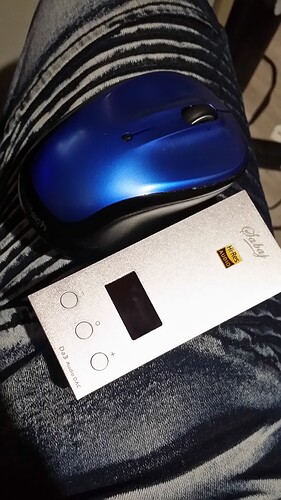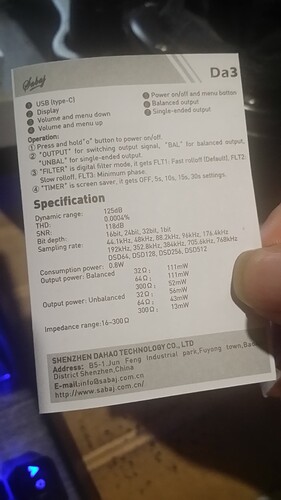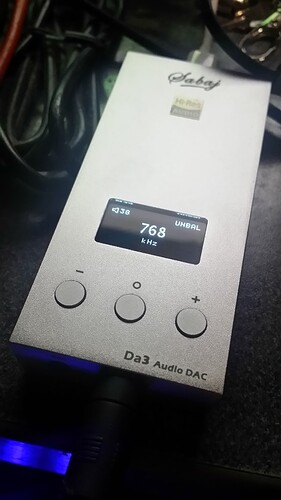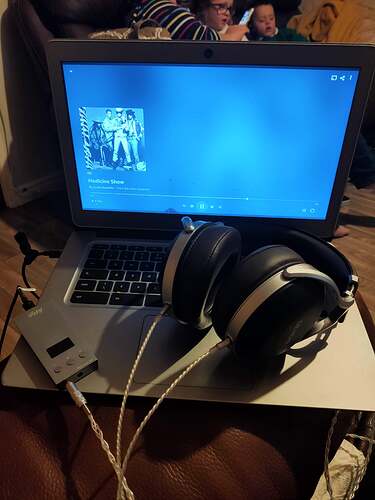This is a smol 100$-ish DAC/Amp with two ESS chipsets. An interesting one, because it’s USB-powered. You get a DAC, an amp, a 3.5mm (unbalanced) output, and a 2.5mm (balanced) output, and a screen (telling you the volume level, the Khz and if the output is set to balanced or unbalanced, etc.), and no batteries are required. Excellent for portability – that is, IF your smartphone can power it: Some smartphones can’t. You probably need a phone that supports “OTG Power”. The smol manual says it requires 0.8 watts of USB power.
DAC review, or “why not, let’s use it as a desktop dac”:
To review the DAC, I A/B’ed it against a 100$ SMSL Sanskrit 10th (AKM chipset), using a “gohifiaudio S3” RCA switch (…it’s a 100$ box of metal, I trust it), all into a Liquid Spark headphone amp. Yes, I amped the dac/amp: Simply put the Sabaj’s volume to the max, and you get the standard 2V “line out” volume (but from the “headphone out”). Mostly tested with my “daily driver” Fostex T50RP’s. Note that they’re not balanced. I can’t test the 2.5mm out with anything.
Bass, mids, treble:
Whereas the Sanskrit 10th tends to prioritize the bass and mids, the Sabaj Da3 tends to prioritize the treble. There’s a lack of sub-bass compared to the Sanskrit 10th (I noticed a lack of sub-bass when I was comparing the JDS Atom amp to the Liquid Spark amp too, and now I notice a lack of sub-bass from this Sabaj Da3 plugged into the Liquid Spark… BIG lack of sub-bass from this DAC then). Therefore bass sounds way “clearer” with the Sabaj Da3, but obviously thinner. The Sanskrit 10th got more bass, more sub-bass, might sound “muddy” at times even, but never thin. With the Da3, female voices will sound a bit more glorious. High treble or “air” (including cymbals and “esses”) will be a tad more prominent. Filter FL2 (slow rolloff) instead of FL1 (fast rolloff) sounds better for me (yup, there’s filters too!).
Soundstage:
The soundstage from the Sanskrit 10th is small and… huh, correct, i.e.: “round”. The Sabaj Da3 got two ESS chipsets, and this makes the soundstage noticeably bigger. Great! But the soundstage can seem “eye-shaped” at times – because prioritizing the treble gave this DAC implementation a lack of depth. Never “thinness”, though: Clarity is the word. This lil’ DAC will add a bit of “airiness” to your amps and headphones.
Detail:
In Rodrigo Y Gabriela - Stairway to Heaven, the difference is night and day. With the Sanskrit 10th (AKM), you feel like in a bassy room. With the Sabaj Da3 (ESS), you don’t. But details jump at you. You hear the hand of the guitarist gliding on the guitar neck, going up and down on the neck during string bends. You hear him breathing. Everything is as prominent as the guitar itself. Yes, I hear all this with the Sanskrit 10th too… in the background. Should it be in the background? Well, probably, honestly. Should the Sabaj Da3 have better sub-bass? Obviously. Still, all this makes the Sabaj Da3, used as a desktop DAC, sound a bit “ethereal”. An interesting experience.
DAC+AMP review, or, “as it was meant to be”:
They engineered a bit of smoothness for the headphone amp. Yes, I know, it’s the exact same output I plugged into the Liquid Spark – but for headphones, it’s different: Headphone impedance will obviously drastically affect the sound… And it does. The headphone 3.5mm out, with actual headphones plugged in, adds bass to em. TL,DR: This makes the Sabaj Da3 an inexpensive, not overly detailed in the treble, portable DAC with great soundstage (…“round” soundstage yes lol), and decent bass and depth. Definitely better than any smartphone 3.5mm out. (The 2.5mm out might be better, but again, I can’t test the 2.5mm out with anything).
So, pairings, as a portable DAC:
Well, this is simple. This will be better than your smartphone DAC, and two ESS chipsets will probably be better than anything your smartphone has already. But… if you’re reading this, your smartphone probably doesn’t even have a 3.5mm out. I used to be against the lack of 3.5mm headphone outs in new smartphones “in favor of” bluetooth. But if it’s the disappearance of these headphone outs in favor of Sabaj Da3’s, I’m 100% for it. No headphone out can sound as glorious and detailed as this in a smartphone – with the added peace of mind of the little screen showing you that your operating system isn’t doing any shenanigans, because your 96Khz file is actually sent to the DAC, and played, in 96Khz, for example.
Pairings… as a desktop DAC:
The abundance of remarkable treble details but prioritized over all the bass and mids, in my system, and also my possibly unhealthy need for extended sub-bass (…I’ve done electronic music), and my already treble-y speakers, makes me prefer my Sanskrit 10th over the Sabaj Da3. If you’re treble-sensitive or just prefer bass and male vocals to female vocals and cymbals and “etherealness”, this is not for you. But if you have headphones and/or speakers with too much bass. And/or muddy bass. And/or lacking clarity in the highs. And/or lacking soundstage: This is for you. If you want absolutely everything to sound clearer, wider and more detailed, this is for you.
Final thoughts:
The Sabaj Da3 (and SMSL Sanskrit 10th) are obviously not perfect implementations of AKM and ESS chipsets – for 100$ some will say these are cheap implementations – but this is a great experience that allowed me to compare a 100$ AKM DAC vs a 100$ ESS DAC – and I definitely heard the difference. ESS has always been a synonym of clarity, and now I understand why (Side note: I already reviewed the Bludento BLT-2 bluetooth DAC with a Burr Brown chipset, too, and this one sounded way smoother than both these ESS and AKM dacs).
Fun facts:
-
This DAC does 32bit/768khz. I’m now listening to 24bit/384khz (and more) files, and… if you want more depth and bass from this tiny little thing, this actually might be a way to get some of it. Remember, the yellow hi-res audio stickers might just be useless and “snake oil”, but the chipsets can actually sound better when asked to convert more bits and Khz than “standard”, and it sounds like it. Expensive dacs mostly won’t care if it’s 16bit/44.1khz or 32bits/768khz, but cheap DACs sometimes do. They just work differently when “pushed”. Still, my tests were done with mostly .wav files and 320kbps mp3’s, and… Well yes, people who buy high-res audio CDs usually pay more than 100$ for their DACs.
-
My copy of “Rodrigo Y Gabriela - Stairway to Heaven” is apparently a mp3 file with variable bitrate (from 192 to 320kbps). The Sabaj Da3 ESS chipsets still managed to get all these details… from this crappy, over-compressed piece of shi- mp3 (insert claps here).
-
Oddly enough, even the 3.5mm unbalanced out will power T50RP’s to dangerous volumes. Yes, you can take your T50RP’s on the bus with that. How? I don’t know. Is it perfect? Obviously not. Is it better than Bluetooth? Obviously yes. Will it be enough to power Tin P1’s? That’d be a good deal.




